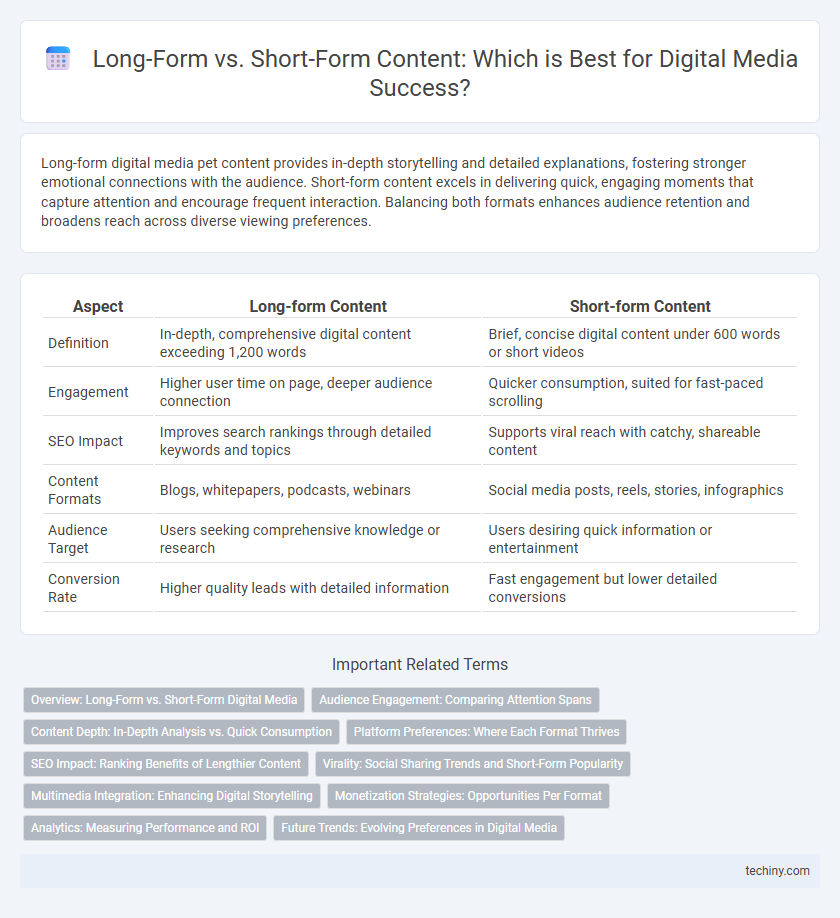Long-form digital media pet content provides in-depth storytelling and detailed explanations, fostering stronger emotional connections with the audience. Short-form content excels in delivering quick, engaging moments that capture attention and encourage frequent interaction. Balancing both formats enhances audience retention and broadens reach across diverse viewing preferences.
Table of Comparison
| Aspect | Long-form Content | Short-form Content |
|---|---|---|
| Definition | In-depth, comprehensive digital content exceeding 1,200 words | Brief, concise digital content under 600 words or short videos |
| Engagement | Higher user time on page, deeper audience connection | Quicker consumption, suited for fast-paced scrolling |
| SEO Impact | Improves search rankings through detailed keywords and topics | Supports viral reach with catchy, shareable content |
| Content Formats | Blogs, whitepapers, podcasts, webinars | Social media posts, reels, stories, infographics |
| Audience Target | Users seeking comprehensive knowledge or research | Users desiring quick information or entertainment |
| Conversion Rate | Higher quality leads with detailed information | Fast engagement but lower detailed conversions |
Overview: Long-Form vs. Short-Form Digital Media
Long-form digital media, typically exceeding 1,000 words or 10 minutes of video, enables in-depth exploration of complex topics and fosters greater audience engagement and trust. Short-form content, usually under 2 minutes or 500 words, caters to rapid consumption, driving high reach and frequent sharing on platforms like TikTok, Instagram, and Twitter. Balancing long-form and short-form strategies maximizes audience retention, SEO performance, and content versatility across diverse digital channels.
Audience Engagement: Comparing Attention Spans
Long-form digital media content tends to engage audiences with in-depth storytelling and comprehensive information, appealing to viewers with longer attention spans seeking detailed insights. Short-form content captures attention quickly, catering to fragmented social media consumption habits and driving higher engagement rates through concise, impactful messaging. Platforms like TikTok and Instagram Reels thrive on short-form formats, while podcasts and in-depth YouTube videos demonstrate the effectiveness of long-form content for sustained viewer interaction.
Content Depth: In-Depth Analysis vs. Quick Consumption
Long-form digital media offers comprehensive content depth, providing detailed analysis and thorough exploration of complex topics that engage audiences seeking substantial information. Short-form content prioritizes quick consumption, enabling users to absorb key points rapidly through concise, easily digestible formats ideal for mobile and social media platforms. Balancing in-depth analysis with brevity is essential for optimizing viewer retention and meeting diverse audience preferences in digital marketing strategies.
Platform Preferences: Where Each Format Thrives
Long-form content excels on platforms like YouTube and blogs, where audiences seek in-depth explanations and comprehensive storytelling. Short-form videos dominate TikTok, Instagram Reels, and Snapchat, catering to users who prefer quick, engaging, and easily digestible clips. Each format thrives by aligning with platform algorithms designed to maximize user engagement and retention.
SEO Impact: Ranking Benefits of Lengthier Content
Lengthier digital media content typically offers enhanced SEO benefits by incorporating more relevant keywords and providing comprehensive coverage of topics, which increases dwell time and reduces bounce rates. Long-form content tends to generate higher engagement through in-depth analysis, boosting organic rankings on search engines like Google. Search algorithms favor detailed content that satisfies user intent, making long articles more effective for achieving sustained search visibility and authority.
Virality: Social Sharing Trends and Short-Form Popularity
Short-form digital media dominates social sharing trends due to its quick consumption and high engagement rates, often going viral across platforms like TikTok, Instagram Reels, and Snapchat. Long-form content, while less frequently shared, provides in-depth storytelling that boosts viewer retention and brand authority. The rise of short-form videos reflects a shift in consumer behavior favoring immediate, snackable content optimized for mobile viewing and algorithm-driven discovery.
Multimedia Integration: Enhancing Digital Storytelling
Multimedia integration significantly enhances both long-form and short-form digital media by combining text, video, audio, and interactive elements to create immersive storytelling experiences. Long-form content benefits from in-depth multimedia layers that maintain audience engagement over extended durations, while short-form content leverages concise, impactful visuals and sound to quickly convey messages and capture attention. Effective use of multimedia tools such as VR, AR, and interactive graphics enriches narrative depth and emotional connection across digital platforms.
Monetization Strategies: Opportunities Per Format
Long-form digital media enables deeper audience engagement, attracting premium advertisers willing to invest in detailed content, resulting in higher CPM rates and subscription-based revenue models. Short-form content thrives on volume and virality, generating profits through ad impressions, sponsorships, and influencer partnerships that capitalize on rapid consumer attention. Each format leverages distinct monetization strategies, with long-form focusing on quality and retention, while short-form emphasizes breadth and frequency to maximize revenue.
Analytics: Measuring Performance and ROI
Long-form content generates higher engagement rates by providing detailed information that increases time-on-page metrics, which is crucial for improving SEO rankings and brand authority. Short-form content, with its quick consumption nature, drives rapid social media interactions and higher shareability, leading to increased impressions and click-through rates (CTR). Measuring ROI involves analyzing metrics such as conversion rates, bounce rates, and customer acquisition costs tailored to the content's format and campaign goals.
Future Trends: Evolving Preferences in Digital Media
Long-form digital media is expected to grow as audiences seek in-depth storytelling and comprehensive content, particularly in podcasts, video essays, and webinars. Short-form content will continue dominating platforms like TikTok, Instagram Reels, and YouTube Shorts due to its immediate engagement and shareability. Emerging AI-driven personalization and immersive technologies such as AR and VR will further reshape consumption patterns, balancing the demand between long-form depth and short-form brevity.
Long-form vs Short-form Infographic

 techiny.com
techiny.com